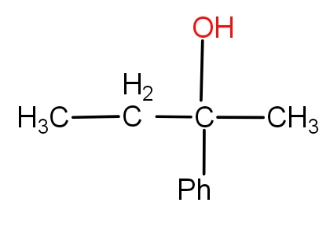

Can not be prepared by :
a.) HCHO +
b.)
c.)
d.)

Answer
512.1k+ views
Hint: The Grignard reagent reacts with formaldehyde to form primary alcohol while with all other aldehydes, it forms second alcohol. And further, the Grignard reagent with ketones yields tertiary alcohol. On the basis of this, we see that the options that have a group other than ketone will be the correct answer.
Complete step by step answer :
We know that RMgX is Grignard reagent. The Grignard reagent reacts with formaldehyde to form primary alcohol while with all other aldehydes, it forms second alcohol. And further, the Grignard reagent with ketones yields tertiary alcohol. The product given to use is tertiary alcohol. So, the answer would be the reaction of Grignard reagent with ketone. Now, let us see the options given to us.
-So, the first option is HCHO and
-The formaldehyde is an aldehyde. It reacts with
-The second option we have is
-The third option is
-The fourth option given is
So, the correct answer is option a.).
Note: It must be noted that Grignard reagent is an organometallic compound. It has a direct metal carbon bond. It is used to form carbon-carbon bonds. Water and air can destroy the Grignard reagent. So, the reaction with the Grignard reagent is done in an inert atmosphere.
Complete step by step answer :
We know that RMgX is Grignard reagent. The Grignard reagent reacts with formaldehyde to form primary alcohol while with all other aldehydes, it forms second alcohol. And further, the Grignard reagent with ketones yields tertiary alcohol. The product given to use is tertiary alcohol. So, the answer would be the reaction of Grignard reagent with ketone. Now, let us see the options given to us.
-So, the first option is HCHO and
-The formaldehyde is an aldehyde. It reacts with
-The second option we have is
-The third option is
-The fourth option given is
So, the correct answer is option a.).
Note: It must be noted that Grignard reagent is an organometallic compound. It has a direct metal carbon bond. It is used to form carbon-carbon bonds. Water and air can destroy the Grignard reagent. So, the reaction with the Grignard reagent is done in an inert atmosphere.
Recently Updated Pages
Master Class 12 Business Studies: Engaging Questions & Answers for Success

Master Class 12 Economics: Engaging Questions & Answers for Success

Master Class 12 English: Engaging Questions & Answers for Success

Master Class 12 Maths: Engaging Questions & Answers for Success

Master Class 12 Social Science: Engaging Questions & Answers for Success

Master Class 12 Chemistry: Engaging Questions & Answers for Success

Trending doubts
What is transplantation in agriculture class 12 biology CBSE

Hydrological cycle is controlled by A Grasslands B class 12 biology CBSE

Who discovered the cell and how class 12 biology CBSE

Distinguish between the democratic government and nondemocratic class 12 social science CBSE

How will you obtain OR AND gates from the NAND and class 12 physics CBSE

What is the difference between Latitude and Longit class 12 physics CBSE




